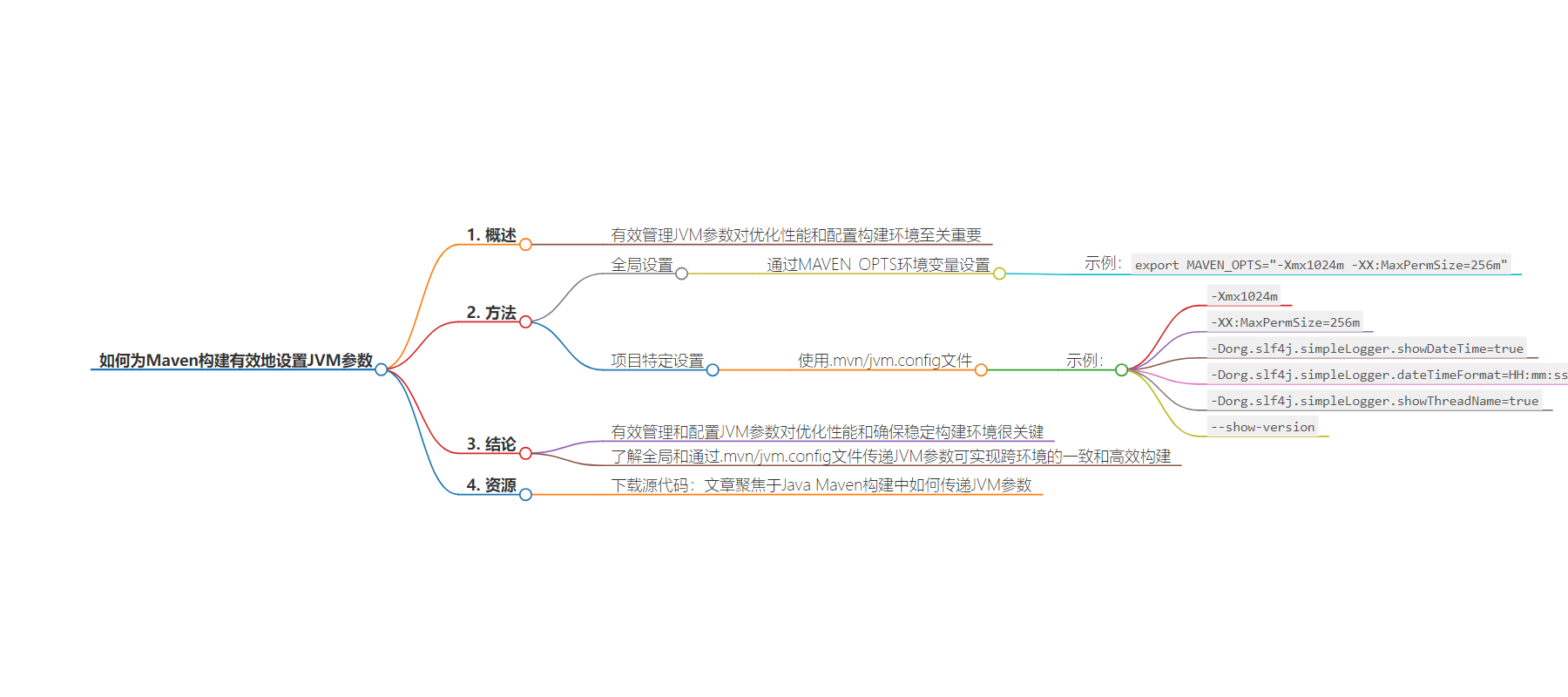包阅导读总结
1. 关键词:JVM Arguments、Maven Builds、Performance Optimization、Build Environment、Configuration
2. 总结:本文介绍了在 Java 开发中为 Maven 构建有效设置 JVM 参数的方法,包括通过全局配置和使用.mvn/jvm.config 文件,还展示了相关示例和输出效果,强调了其对优化性能和稳定构建环境的重要性。
3. 主要内容:
– 有效管理 JVM 参数对优化性能和配置构建环境很重要
– 全局配置
– 通过配置 MAVEN_OPTS 环境变量为所有 Maven 构建设置全局 JVM 参数
– 项目特定配置
– 使用.mvn/jvm.config 文件为特定项目的所有 Maven 构建定义 JVM 参数
– 示例包括设置堆大小、永久代大小、SLF4J 日志相关属性和显示 JVM 版本等
– 结论
– 有效管理配置 JVM 参数对 Java Maven 项目至关重要,能确保不同环境构建的一致性和高效性
思维导图:
文章地址:https://www.javacodegeeks.com/how-to-set-jvm-arguments-for-maven-builds.html
文章来源:javacodegeeks.com
作者:Omozegie Aziegbe
发布时间:2024/7/29 10:40
语言:英文
总字数:729字
预计阅读时间:3分钟
评分:84分
标签:JVM 参数,Maven,Java 开发,构建自动化,性能优化
以下为原文内容
本内容来源于用户推荐转载,旨在分享知识与观点,如有侵权请联系删除 联系邮箱 media@ilingban.com
Effectively managing JVM arguments is essential for optimizing performance and configuring the build environment in modern Java development. Apache Maven offers several methods to pass JVM arguments, ensuring that our application runs smoothly across different environments.
One effective way to manage these settings is through Maven’s global configuration options, which allow us to apply JVM arguments consistently across all builds. Additionally, we can leverage project-specific configurations to tailor the JVM settings according to our project’s needs. This article will guide you through various methods to pass JVM arguments in Maven, including setting them globally and using the .mvn/jvm.config file.
1. Passing JVM Arguments Globally
To set JVM arguments globally for all Maven builds, we can configure the MAVEN_OPTS environment variable. The MAVEN_OPTS environment variable allows us to specify JVM arguments that will be applied to all Maven builds. This is a convenient method for setting global options without modifying project files.
export MAVEN_OPTS="-Xmx1024m -XX:MaxPermSize=256m"
This sets the maximum heap size to 1024 MB and the maximum permanent generation size to 256 MB for all Maven builds.
2. Setting Default JVM Options via jvm.config
Another approach to specifying JVM arguments for Maven builds is to use the .mvn/jvm.config file. This file allows us to define JVM arguments that will be applied to all Maven builds for a specific project. This method is useful when we want to ensure consistent JVM settings across different environments and team members working on the same project.
To use this method, we need to create a .mvn directory in the root of our Maven project if it doesn’t already exist. Inside this directory, create a file named jvm.config and add your JVM arguments to it.
Here is an example of a Maven project directory structure including the .mvn/jvm.config file:
Now, we can manually edit the jvm.config file and add the following content:
-Xmx1024m-XX:MaxPermSize=256m
The .mvn/jvm.config file is read by Maven during the build process, and the JVM arguments specified in this file are applied to the Maven execution. This ensures that every time you or someone else runs Maven for this project, the specified JVM settings are used, providing consistency across different development environments.
The .mvn/jvm.config file can be enriched with various JVM arguments and system properties to customize our build environment further. Below, we will add some additional configurations including system properties for SLF4J logging and a flag to show the JVM version.
-Xmx1024m-XX:MaxPermSize=256m-Dorg.slf4j.simpleLogger.showDateTime=true-Dorg.slf4j.simpleLogger.dateTimeFormat=HH:mm:ss-Dorg.slf4j.simpleLogger.showThreadName=true--show-version
-Xmx1024m: Sets the maximum heap size to 1024 MB.-XX:MaxPermSize=256m: Sets the maximum permanent generation size to 256 MB (note: this is specific to older JVMs and may not be needed in newer versions which use metaspace instead of permgen).-Dorg.slf4j.simpleLogger.showDateTime=true: Enables the display of the date and time in SLF4J SimpleLogger output.-Dorg.slf4j.simpleLogger.dateTimeFormat=HH:mm:ss: Sets the format of the date and time in SLF4J SimpleLogger output to hours, minutes, and seconds.-Dorg.slf4j.simpleLogger.showThreadName=true: Enables the display of the thread name in SLF4J SimpleLogger output.--show-version: Displays the JVM version information at the start of the Maven build process.
When you run the mvn verify command with the enhanced configuration settings in the .mvn/jvm.config file, you will notice several key pieces of information in the output:
Java HotSpot(TM) 64-Bit Server VM warning: Ignoring option MaxPermSize; support was removed in 8.0java 11.0.11 2021-04-20 LTSJava(TM) SE Runtime Environment 18.9 (build 11.0.11+9-LTS-194)Java HotSpot(TM) 64-Bit Server VM 18.9 (build 11.0.11+9-LTS-194, mixed mode)10:29:54 [main] [INFO] Scanning for projects...10:30:06 [main] [INFO] ------------------------------------------------------------------------10:30:06 [main] [INFO] BUILD SUCCESS10:30:06 [main] [INFO] ------------------------------------------------------------------------10:30:06 [main] [INFO] Total time: 12.090 s10:30:06 [main] [INFO] Finished at: 2024-07-27T10:30:06+01:0010:30:06 [main] [INFO] ---------------------------------------------------------
The output shows detailed JVM version information, improved logging with timestamps and thread names, and optimized memory settings.
3. Conclusion
In conclusion, effectively managing and configuring JVM arguments is a crucial aspect of optimizing performance and ensuring a stable build environment in Java Maven projects. By understanding how to pass JVM arguments globally and through the .mvn/jvm.config file, we can achieve consistent and efficient builds across different environments. These techniques not only enhance the performance of our applications but also simplify the management of project-specific configurations.
4. Download the Source Code
This article focused on how to pass JVM arguments in Java Maven builds.
